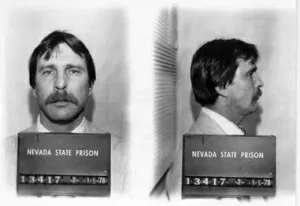Jesse Bishop was executed by the State of Nevada for the murder of a man during a robbery
According to court documents Jesse Bishop would murder a man during a robbery at a Las Vegas Casino
Jesse Bishop would be arrested, convicted and sentenced to death
Jesse Bishop would be executed on October 22, 1979 by way of the gas chamber
Jesse Bishop would brag he murdered 18 people however this was never proven
Jesse Bishop Photos

Jesse Bishop FAQ
When was Jesse Bishop execution
Jesse Bishop was executed on October 22, 1979
How was Jesse Bishop executed
Jesse Bishop was executed by way of the gas chamber
Jesse Bishop Case
He had three wishes: to be with a woman, to have a fifth of Jack Daniel’s and to be executed with dispatch. A few minutes after midnight today, the people of Nevada granted Jesse Walter Bishop only the last one.
Bishop, condemned to death on a murder conviction, went as calmly and as boldly as he said he would. He gestured to and smiled at the 14 official witnesses. He pointed at the floor to indicate that the deadly cyanide pellets had reached a waiting vessel of acid.
He wrinkled his nose, witnesses said, at the first fumes. Then came deep, desperate gulps for air. His face turned up to the ceiling of the Nevada state gas chamber. He convulsed, saliva ran from his mouth, his face turned red. His eyes closed and his chin fell to his chest.
At 12:21 a.m. today, Bishop, 46, was pronounced dead, the last scene of a criminal life that began with an armed robbery at age 15 and proceeded seemingly inexorably to today’s conclusion.
Bishop saw it as unavoidable. Prison director Charles L. Wolff Jr. reported Bishop’s last words as these:
“This is just one more step down the road of life that I’ve been headin’ for all my life.”
It was a step that satisfied some, saddened others. As Bishop’s corpse waited in the six-sided gas chamber while the deadly air was cleared, Dan Seaton, a Clark County prosecutor who worked on Bishop’s case, told assembled reporters he advocates the death penalty as a deterrent to those who might otherwise follow the footsteps of people like Jesse Bishop.
Across from the prison, however, about 50 candle-carrying protesters assembled to silently express rage at the official killing of Bishop, which two U.S. Supreme Court justices had called “state-assisted suicide” because of Bishop’s attitude.
On blue cloth, lit from behind by a lantern, they had painted: “Why do we kill people who kill people to show that killing is wrong?”
There was no answer from the prison, only light from the two windows high on the northeast corner of the stone block building, where Bishop was executed.
The execution could have been stopped or delayed, but only by Bishop. He firmly refused to appeal, refused to plead for his own life, refused to put off what he called the inevitable occupational hazard — execution — of his chosen profession.
He just wanted to get it over with.
Then it was over. A telephone rang in the guardhouse by the gate and Howard Pyle of the prison staff emerged to say, “Jesse Walter Bishop was pronounced dead at 12:21 a.m.”
Seven minutes later, Wolff arrived to read various legal instruments, including what was to be done by and for Clark County (Las Vegas), and to report that he, Wolff, had “obeyed said warrant” by and for Clark County, Nev.
He repeated Bishop’s last words and retreated.
Moments later, when a handful of the witnesses appeared, Ann Salisbury, a Los Angeles Herald Examiner reporter who has covered Bishop’s story and talked with him many times, cleared her throat and asked the questions.
They described the raising of a windowshade, disclosing Bishop strapped in one of two white metal chairs, the one on their left. The other was empty. They described how he gestured, how he raised a strapped hand and nodded.
The cyanide pellets were dropped at 12:11 a.m. Bishop’s gasps and spasms took six minutes. He twitched for two more. He was pronounced dead two minutes later.
Bishop was executed for the first-degree murder of David Ballard, a Baltimore man visiting Las Vegas Dec. 20, 1977. Ballard went there to be married and to honeymoon, but only two hours separated Katherine Ballard from becoming a bride and the events that would make her a widow on Dec. 30 when Ballard died
